Motorcycle Investor mag
Subscribe to our free email news
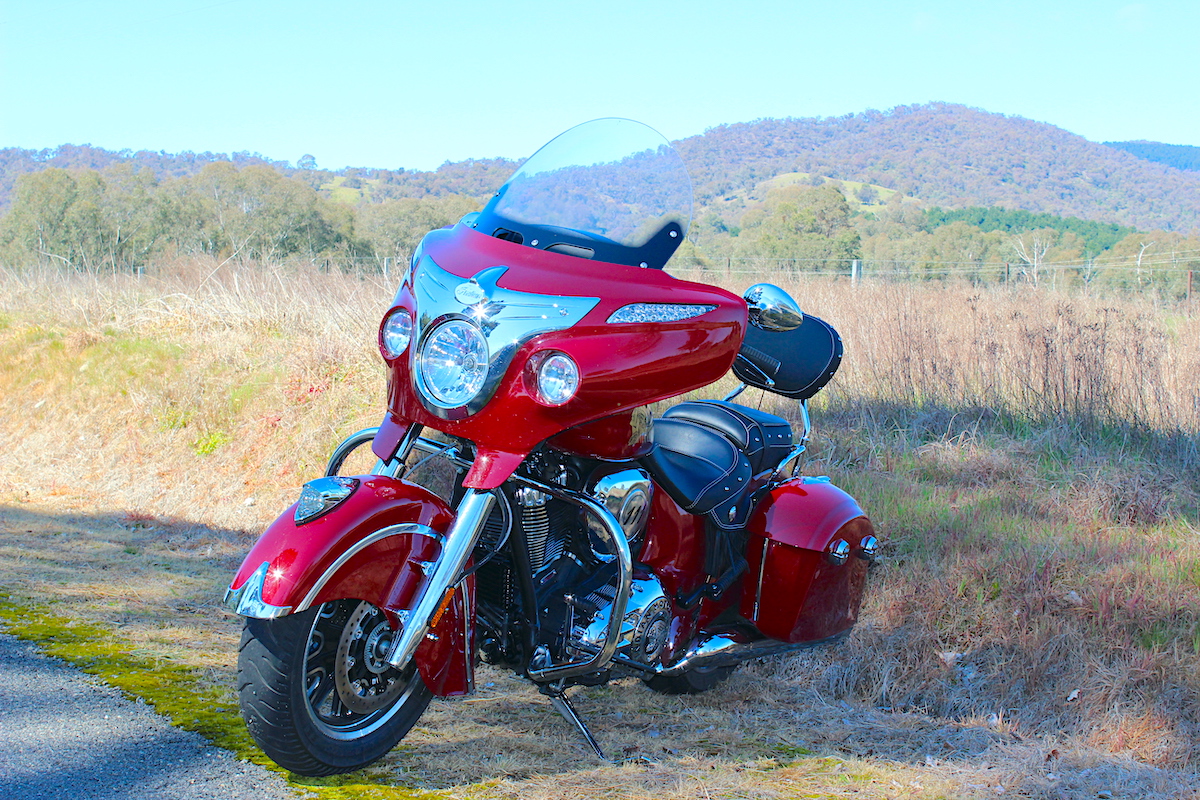
The revivalist
Flashback test: 2015 Indian Chieftain
(Guy 'Guido' Allen, August 2025)
Roll
back a decade and a bit and you might remember
that the revival of Indian Motorcycle (its third
reincarnation over a short period) by Polaris was
big news. Well-funded and with a great record for
its engineering, the company relaunched the
historic marque with some very capable machinery.
Here's our now decade-old test of the 2015
top-of-the-range Chieftain, with some handy
updates for anyone in the market for a used
example...
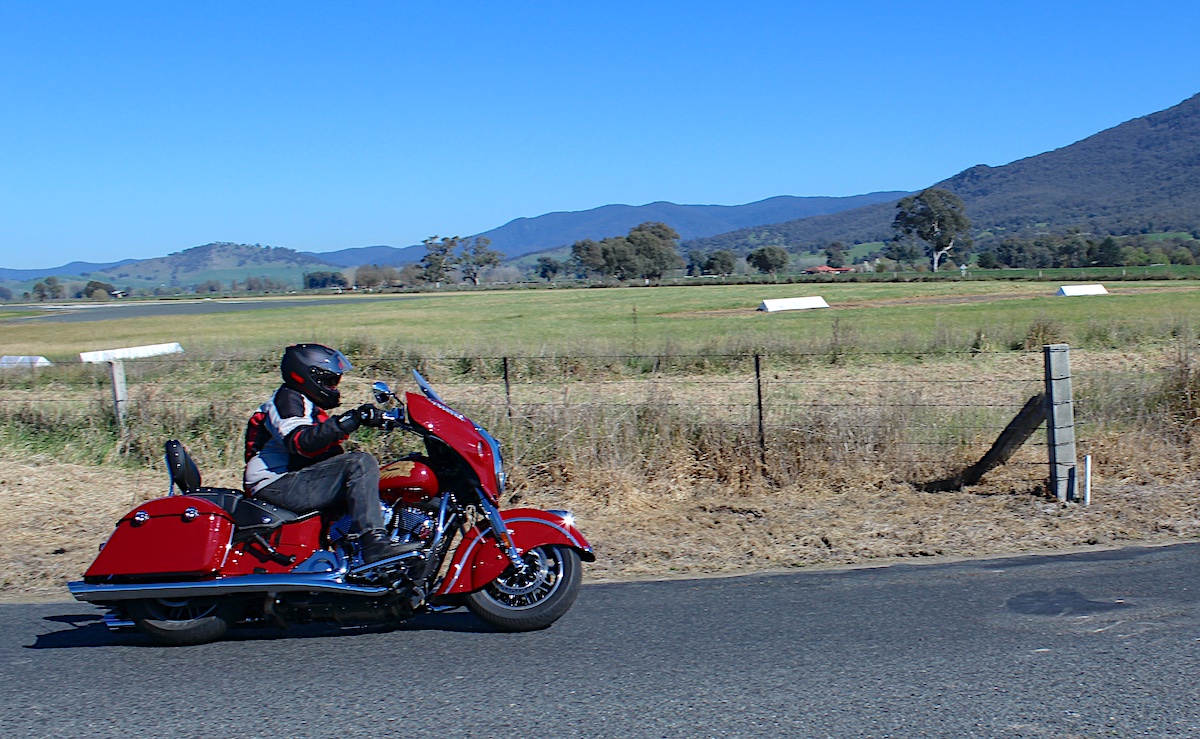
It was
the final swoop on the unsuspecting group of Indian
riders up ahead – many of whom were on 70-year-old
motorcycles and most of whom were making an effort to
behave themselves – that convinced me the Chieftain had
to be returned. And the sooner the better.
I’d been leapfrogging the gang to get some photos and
the casual ability of the Chieftain to descend on the
pack at something approaching warp speed, while
remaining perfectly comfortable and controllable, was
getting under my skin.
Damn it. Adding a third Indian to the fleet would be
ludicrous, even by my loose standards. Time to return it
to the maker, before the ugly subject of money sprang
up. Not that it’s perfect, but more than halfway through
a 1500-ish kilometer trip (our first decent ride on the
thing), there was no question the bagger was pretty good
at its job.
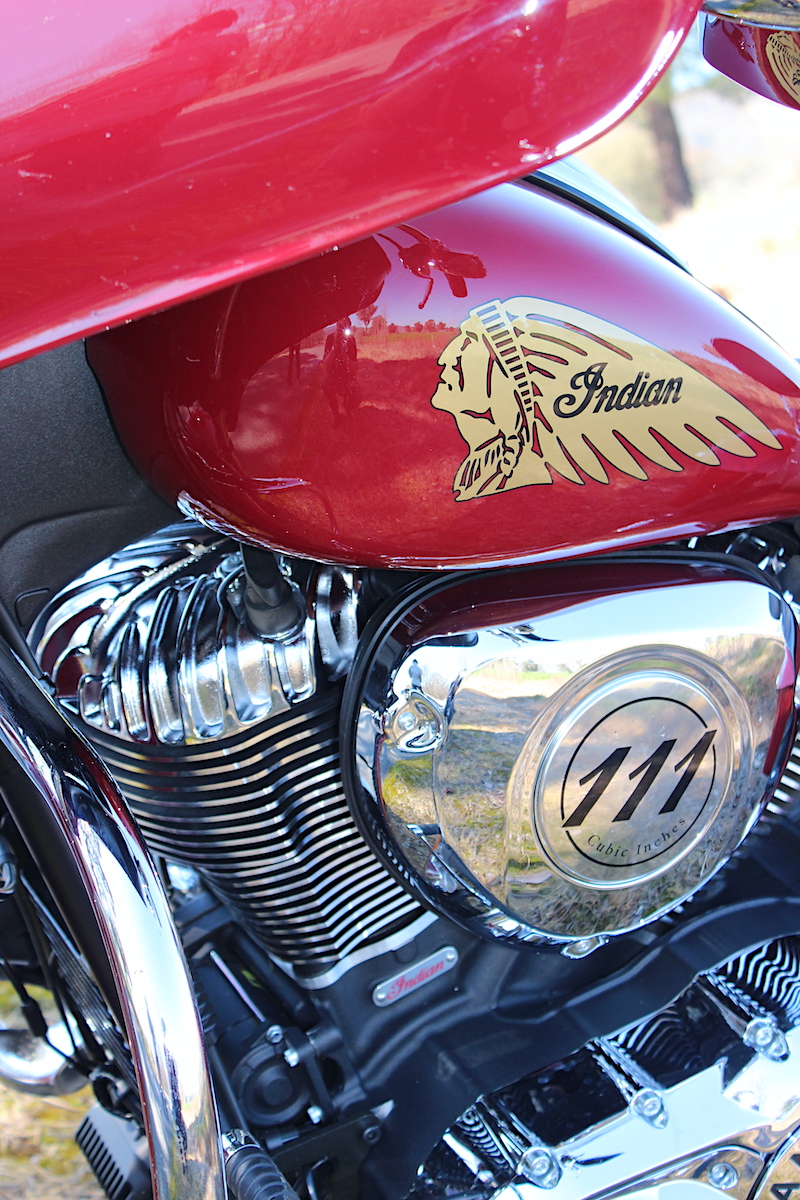
Under the paint
Unveiled as the top-of-the-line offering of a three-bike
line-up in 2013, for the 2014 model year, the Chieftain
represented a few firsts for the Polaris-owned marque.
For a start the name had never been used before. Yep,
we’ve seen it on cars, tanks, trains and aircraft, but
it had somehow escaped the clutches of generations of
Indian Motorcycles marketing departments.
More importantly, it’s the first time the brand has used
a fairing and hard panniers. Sure there have been
windscreens and saddlebags before, but this represented
another step up the touring bike evolutionary scale.
The Chieftain’s brief reign at the top of the corporate
model range has since been relinquished to the
Roadmaster (which is a name Indian has used in the
past), a bike that boasts a topbox, fairing lowers and a
few other niceties. It’s relegated the Chieftain back to
bagger status.
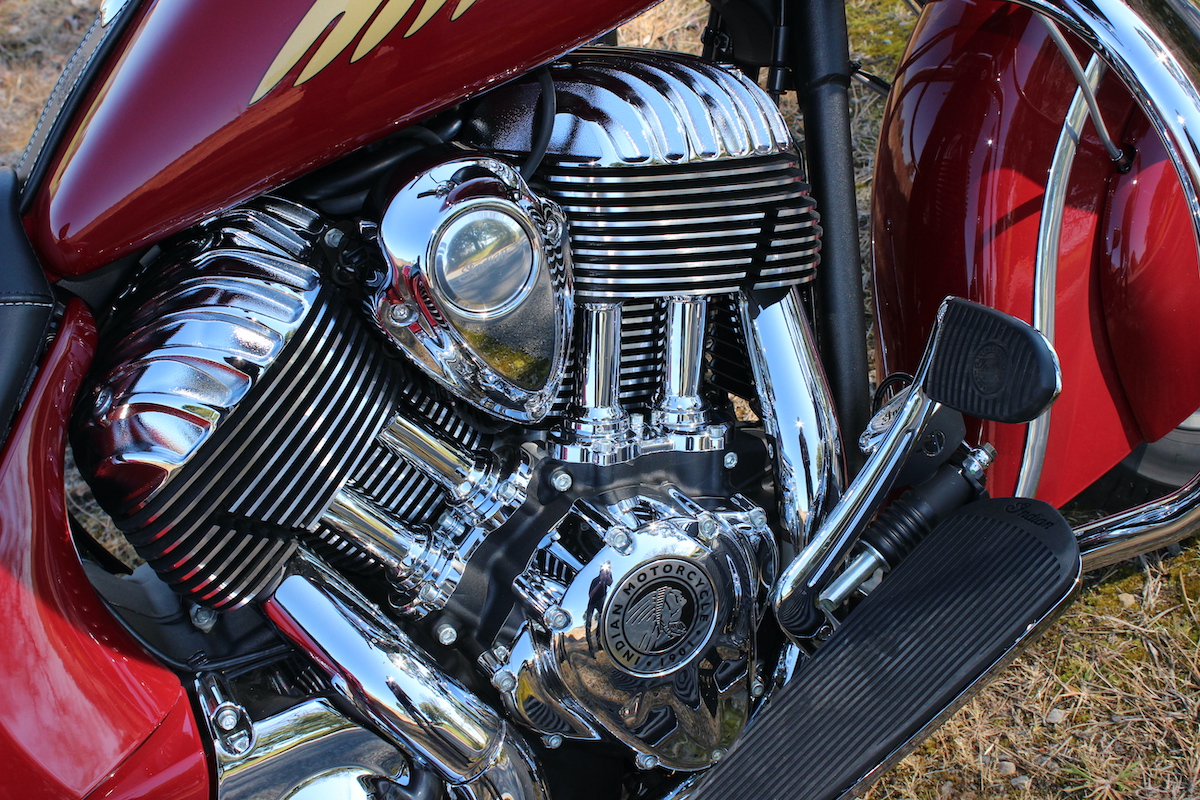
Polaris resisted the temptation to assemble the range
from existing Victory parts, instead opting for close
enough to a clean sheet approach. The star turn is the
Thunderstroke 111 (still not sure of that name…) V-twin
powerplant.
The air-cooled and fuel injected unit has two
pushrod-actuated valves per cylinder (driven by three
cams) and is styled to look (if you squint) like the
company’s 1940s Chief powerplants. There’s a very
conventional six-speed transmission with wet multi-plate
clutch and belt drive.
Referencing the bikes of the past – with the 1947 Chief
named as the focus point – has gone close to being the
company motto, as it’s central to the positioning of the
brand, something reflected in styling cues like the deep
guards front and rear. If you want something that looks
a little avant-garde, talk to sister company Victory.
Suspension is handled by cartridge forks up front while
the rear has twin shock with air preload adjustment.
Braking is pretty conventional too, with four-spotter
twin discs up front and a two-piston rear.
So, nothing so far to get the average tech head’s pulse
racing. Where the Chieftain and its siblings win a lot
of points is the standard fitment of ABS and cruise
control. The former is a very welcome safety net –
particularly on a big cruiser – while the cruise
control is one of things you didn’t know you needed
until you use it. Then you’re hooked.
Speaking of things electric, there’s also a powered
screen with a broad height adjustment, plus a reasonably
powerful stereo, with Bluetooth ability. Keyless
starting is part of the package, along with electronic
anti-theft.
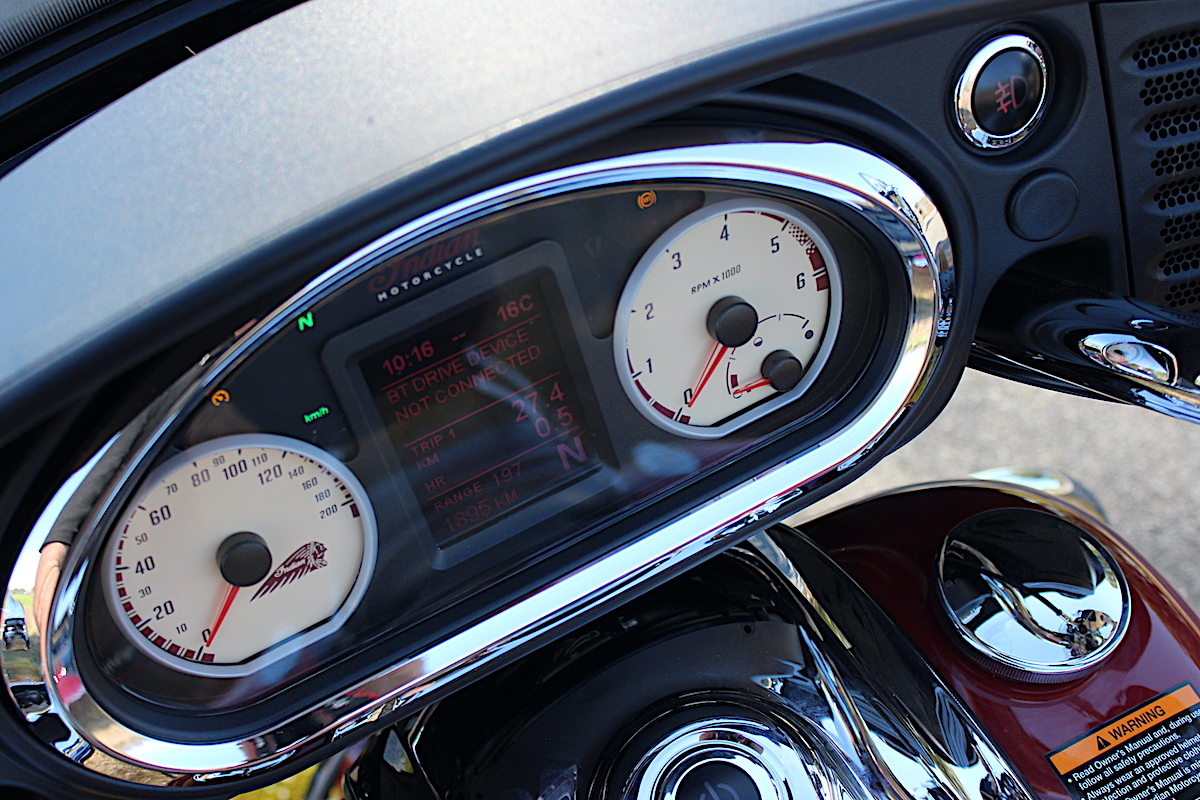
The Chieftain gains more comprehensive instrumentation
than the Chief and Chief Vintage, with a twin-dial
analogue speedo and tacho set-up, separated by a digital
display carrying a host of info including trip and fuel
meters. That display, on early demo bikes, copped some
criticism for being hard to read – something that was
very quickly addressed.
On the road
The general plot was to join the Iron Indian Riders for
a run up to Corryong, on the NSW/Vic border, and head
out into the hills to play for a few days. Travelling
via the Hume is the quickest way there when you’re
running late, but qualifies as cruel and unusual
punishment. It’s heavily policed and crushingly boring,
which is where the combination of a stereo and a cruise
control make all sorts of sense.
A two-hour stint in the saddle to kick things off
provided proof the bike is comfortable enough, with
compliant suspension and decent upholstery. Though it’s
a big motorcycle, it’s not what I’d call vast. At just
shy of 189cm (6’3”), I found it good, but I have ridden
roomier machines – Honda’s Goldwing springs to mind.
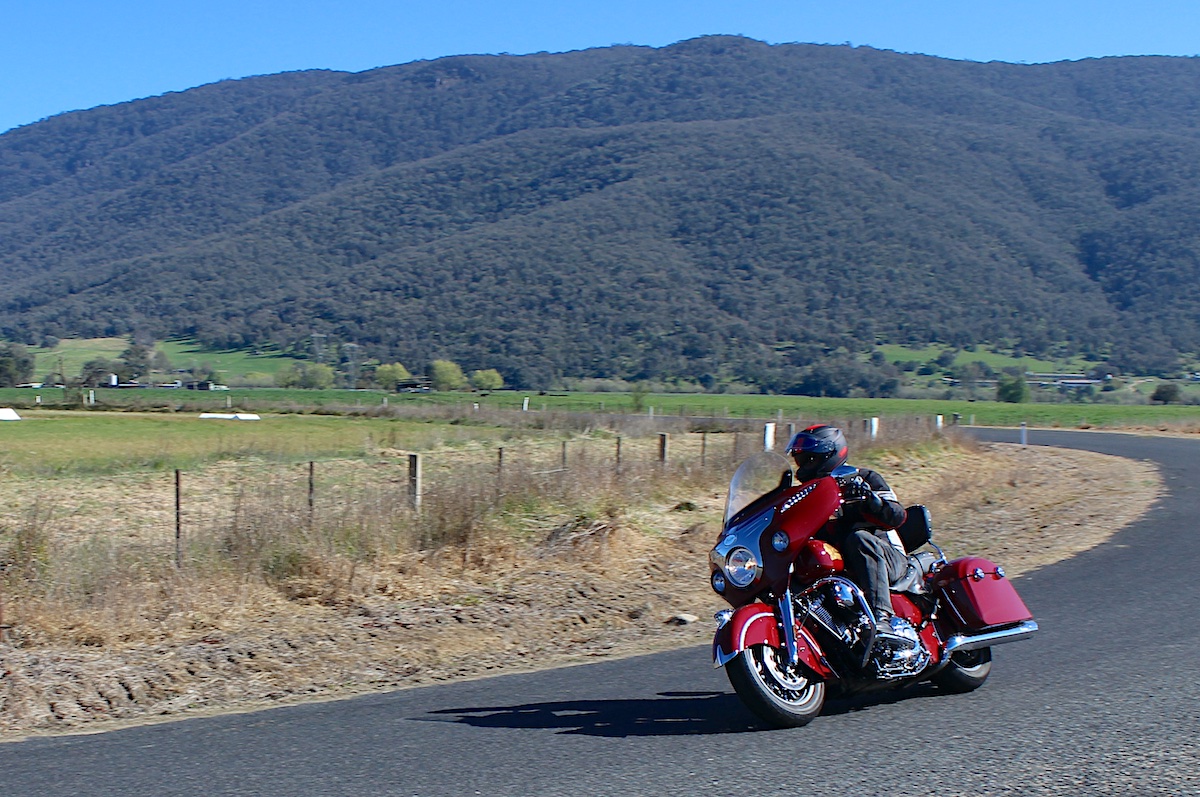
With the screen cranked up to max height, so I was
looking through rather than over it, the stereo speakers
in the fairing had enough of an air pocket to be heard.
A pillion passenger would get less clarity. To me it
would make more sense to kit out with custom-made
earphones, that block external noise and work far
better. They’re readily available through folk such as
Earmold.
Score bonus points for the modest fuel consumption, at
around 16km/lt on cruise at a steady 110km/h. That means
a 300km-plus range, which is respectable. The cruise
control is simple to use and seems well-sorted, with no
surging.
Finally, a few hundred kay up the road, we got to swing
off the Hume and head into the hills. While the
Chieftain is a more than capable freeway cruiser, for me
it starts to shine once the roads develop a few gentle
curves.
Its sheer size and weight work against it – particularly
around town – but it’s capable on a backroad. There’s
around 80 horses on tap, enough to push the monster to
170km/h with authority before it starts to run out of
breath. The tuning is all about low and particularly
mid-range power. The spread is broad and you can
minimize cog-swapping.
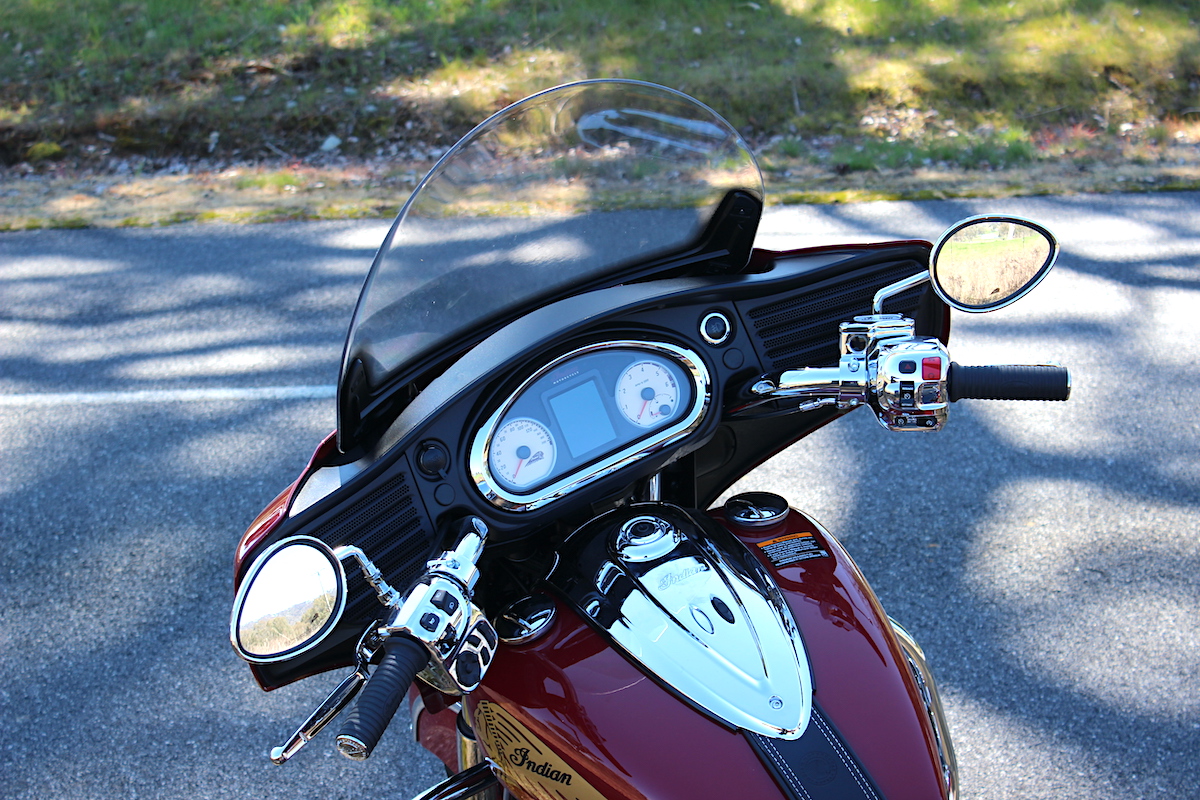
The six-speed shifter works well enough. It’s accurate
if not particularly light. I’d opt for the accessory
heel-toe lever, which should work nicely with the rider
footboards. You may notice some transmission whine,
which is constantly present, but not particularly
intrusive. The clutch is well-sorted with a decent
take-up band.
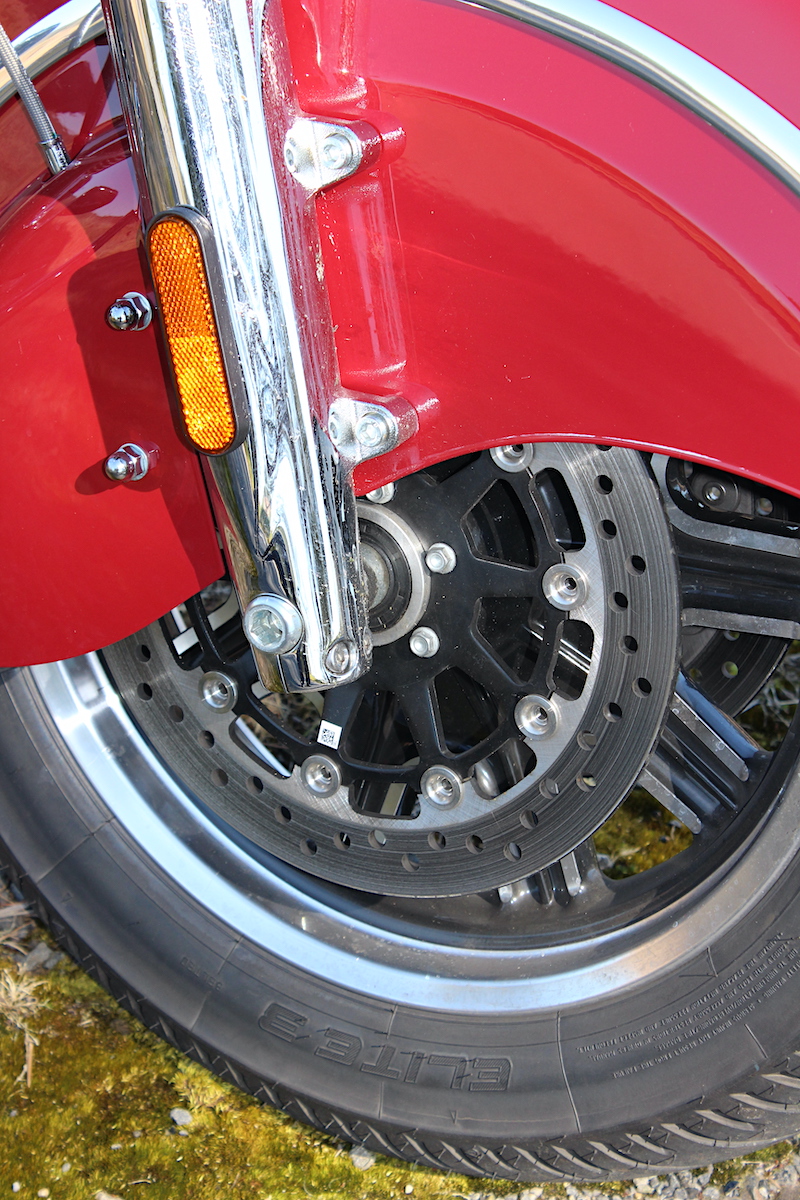
Braking is good – decent feel and power – but not
exceptional. The ABS works.
The Chieftain (and its close sibling the Roadmaster) has
a distinct handling advantage over the Chief and Chief
Vintage, with steeper rake, slightly shorter wheelbase
and a little extra suspension travel on the rear. It has
to do with appearance – the Chieftain in fact has the
steering geometry the engineers wanted, while the
others, with no fairing to hide the front end, were
modified to look ‘right’.
As a result, you get a package that is a touch more
nimble and a better unit in the corners. The difference
isn’t vast, but it’s there. Combine the quicker handling
with halfway decent suspension, and this is a
surprisingly capable package through a set of corners.
Okay, it might feel a bit like you’re taking your
elephant for a gallop, but it works.
It has its limitations. I deliberately threw the thing
into a couple of ropey medium speed turns and eventually
got to feel a little frame flex. But it was under pretty
severe provocation.
All up it’s a reasonably accurate steerer with halfway
respectable handling, and above average dynamics for its
class. It’s certainly enough to make a respectably quick
point-to-point bike.
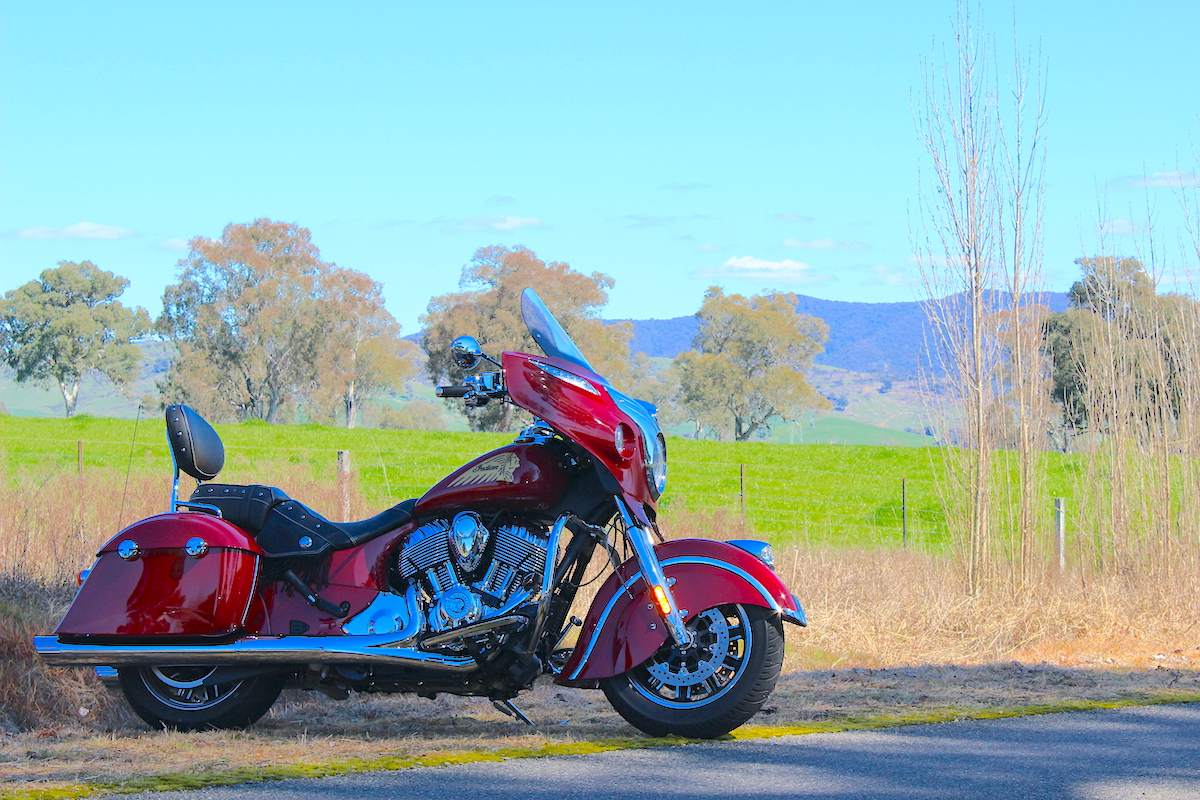
Throw a 65 kilo passenger on the back (combined with a
120 kilo rider) and you’ll find the suspension is still
coping, though the performance envelope narrows a
little. The suspension works harder to recover from
surprises and you notice the reduced cornering
clearance.
If a passenger was likely to be even a semi-regular part
of the picture, I’d be fitting the accessory rear pad
and handgrips shown on the demo bike. Without them,
there’s very little to hang on to.
With that fitted, the overall comfort picture for two is
pretty good. Perhaps the only limitation is the luggage,
which is two mid-sized top-loading panniers. I like top
loaders because you’re less likely to lose stuff if
someone doesn’t shut them properly, though they are a
touch more awkward to pack than side-loaders.
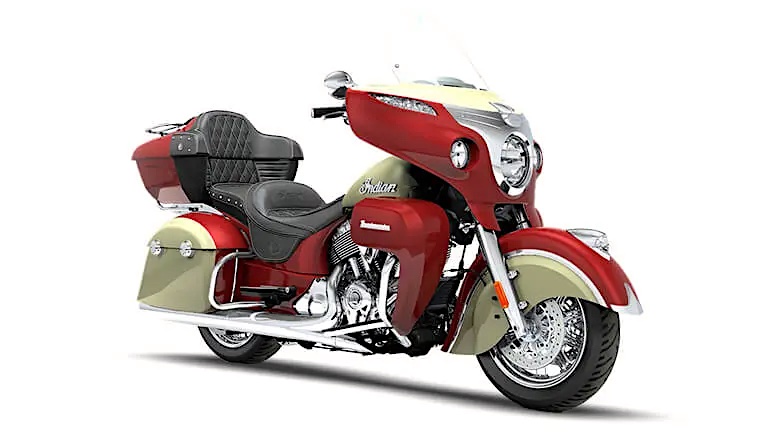
A top-box would be a welcome addition, and you get one
on the Roadmaster.
Worth the rent?
If you’re shopping in the big cruiser/tourer/bagger
market, the idea of a motorcycle priced in the
mid-thirties won’t come as a big shock. Some people buy
Indian because it’s an alternative to Harley-Davidson,
which is fair enough.
If you’re looking for further justification, the
engineering works and the overall packaging is good. If
Indian were silly enough to offer 1500km test rides, I
don’t think they’d get many of them back.
***
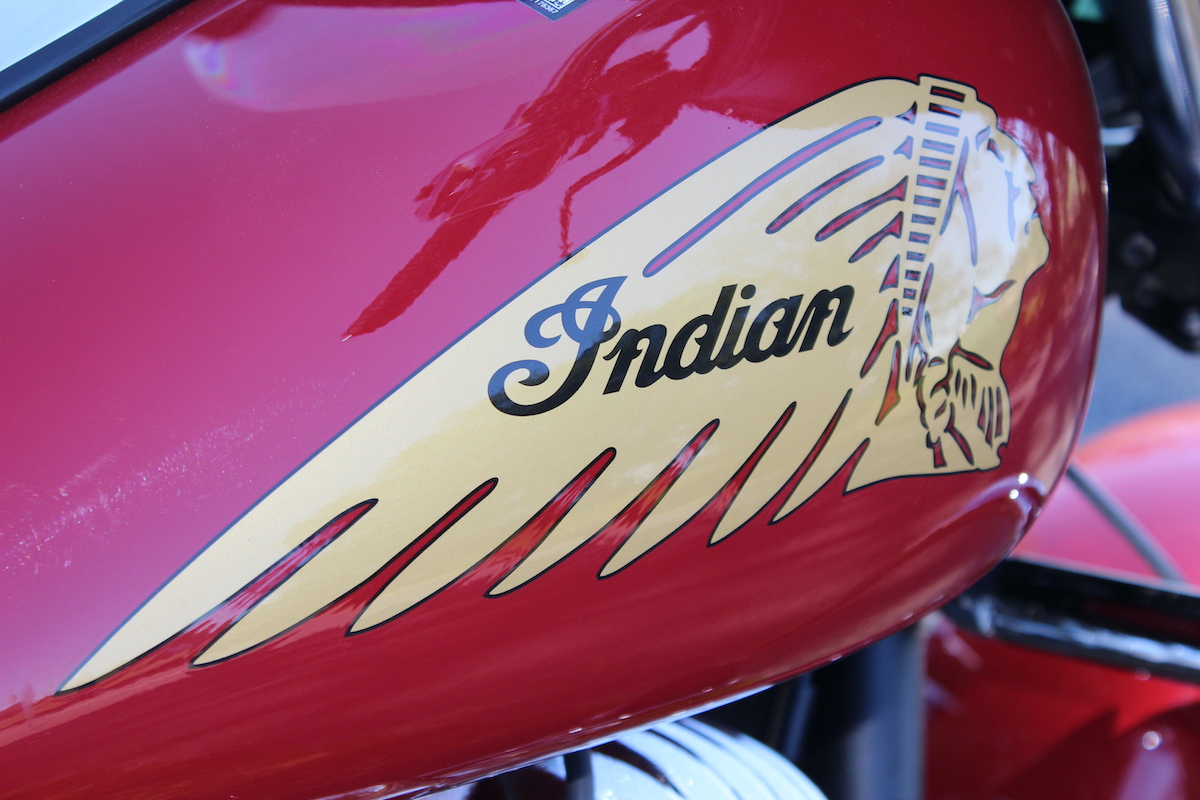
Buying used
August 2025
There is a good supply of these things in the market,
and the odd high-miler (we saw one advertised with
87,000km/54,000 miles) suggests some of them really do
get used and hang together quite well.
Servicing is more or less what you might expect, with
oil and filter changes suggested every 8000km (5000
miles) and as major service at 24,000km (15,000 miles).
Somewhat controversially, the latter includes a fork oil
change partly because Indian specifies mineral rather
than synthetic oil.
Because the motor runs hydraulic tappets, there is no
need for regular valve lash adjustment, though you might
have the gaps checked at every second major service.
Prices for used circa 2015 bikes in Australia seem to be
around Au$20-25,000 (US$13-16,000, GB£9-12,000,
€11-14,000) depending on condition.
Follow this
link to see what bikesales has on offer in the
local market.
***
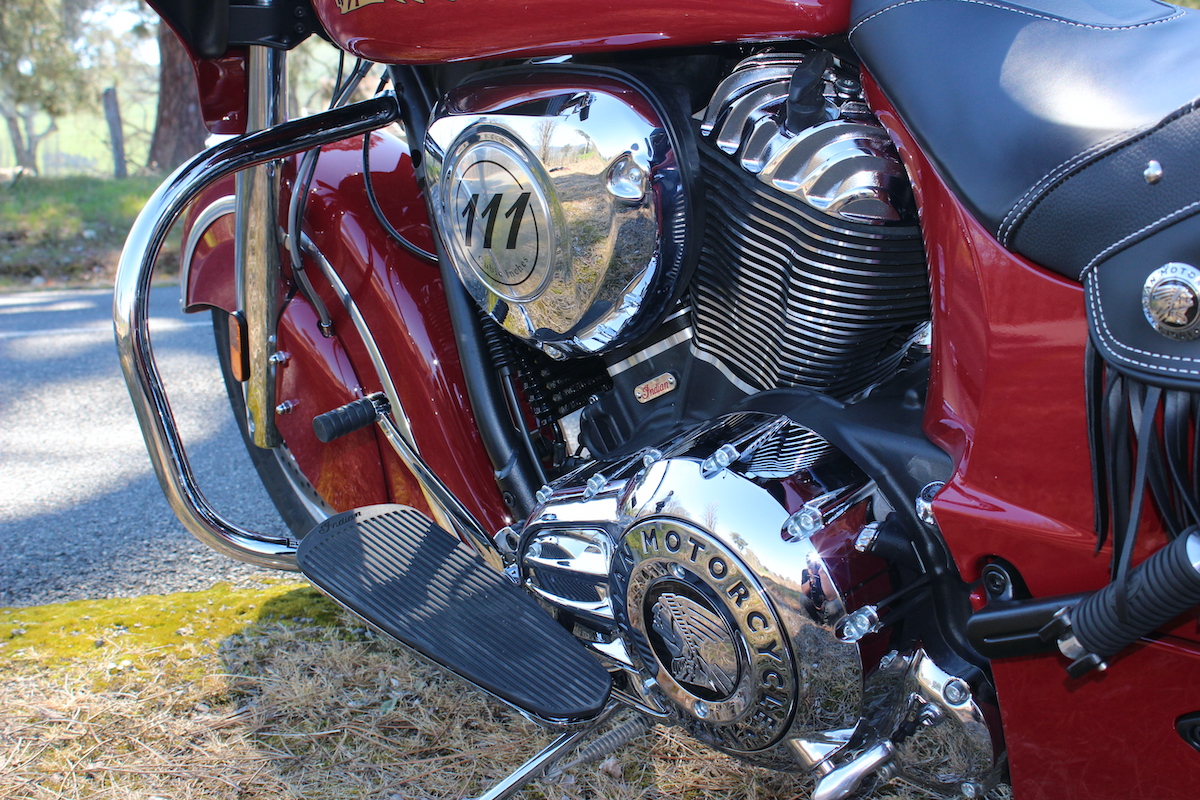
Specifications
2015 Indian Chieftain
Type: 49 degree air-cooled OHV V-twin with
pushrod-operated two valves per cylinder by three cams
Bore and Stroke: 101 x 113mm
Displacement: 1811cc
Compression ratio: 9.5:1
Fuel system: Electronic injection
TRANSMISSION
Type: 6-speed constant mesh
Final drive: Belt
CHASSIS & RUNNING GEAR
Frame type: Composite alloy
Front suspension: Conventional 46mm fork, no adjustment
Rear suspension: Monoshock, preload adjustment
Front brakes: 4-piston 300mm twin discs with ABS
Rear brake: 2-piston, 300mm disc with ABS
DIMENSIONS & CAPACITIES
Dry/wet weight: 370/385kg
Seat height: 673mm
Fuel capacity: 20.8lt
PERFORMANCE
Max power: approx 80hp
Max torque: 16.5kg-m @ 3000rpm
OTHER STUFF
New price: Au$35,995 in the road (US$23,500, GB£17,300,
€20,000)
Warranty: 24 months/unlimited km
Good
Fat midrange power
Nice handling
Good brand
Not so good
Needs decent pillion grips
***
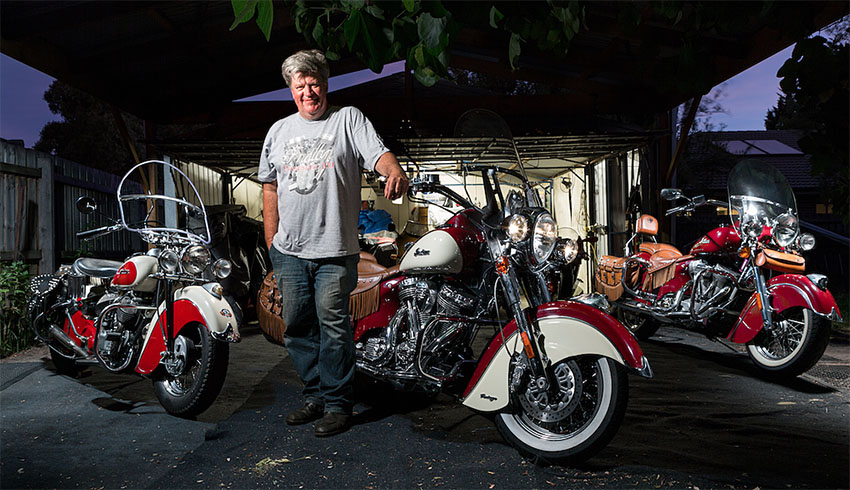
Indian history
Indian first sold motorcycles to the public in 1902 and
became a fierce competitor with Harley-Davidson. The
company’s trademark deep-skirted fenders first appeared
in 1941. World War II was a turning point for the
company, from which it never really recovered.
A post-war change of ownership saw large motorcycle
development slow to a crawl at a time when the company
needed new engines. Meanwhile a venture into smaller
bikes was unsuccessful. The Springfield factory
effectively closed in 1953.
Several failed attempts at reviving the brand were made
over the years. The Indian Motorcycle Company of
America’s Gilroy factory produced bikes from 1999 until
it went bust in 2003.
An upgraded version of the Gilroy design was relaunched
by Stellican from its Kings Mountain factory in 2006.
That effort was bought out by Polaris in 2011. It built
some Kings Mountain bikes at Spirit Lake, before
launching a new range in 201\
Above is the author pictured some years ago with his
1947 Springfield Chief, 2009 Kings
Mountain Chief Vintage and 2003 Gilroy Chief
Vintage. Pic by Ben
Galli.
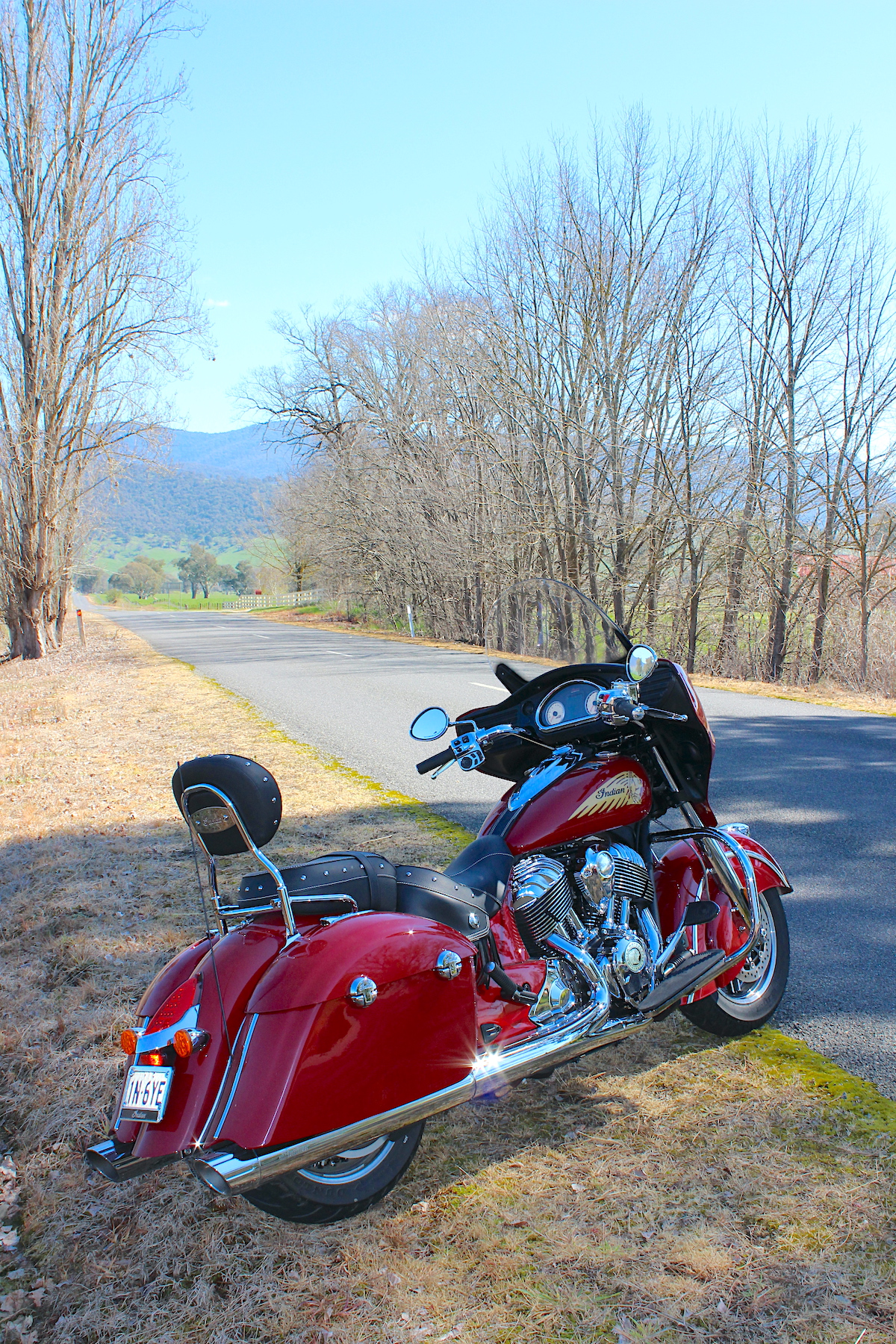
Prior
to buying and reviving Indian, Polaris had established
the Victory motorcycle brand. Sadly, it is no longer in
production.
It did
however produce some great motorcycles.
See our feature on some of the highlights.
***
-------------------------------------------------
Produced by AllMoto abn 61 400 694 722
Privacy: we do not collect cookies or any other data.
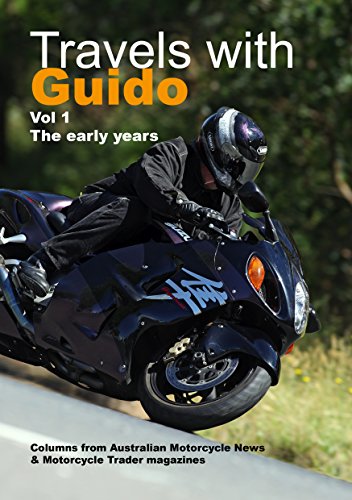
Archives
Contact




